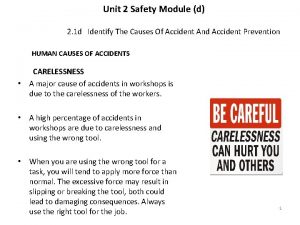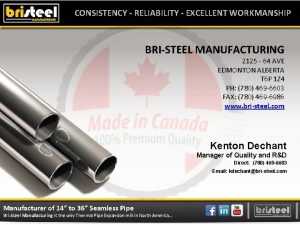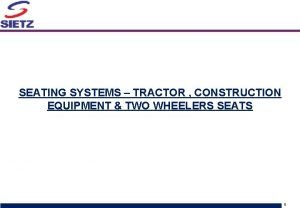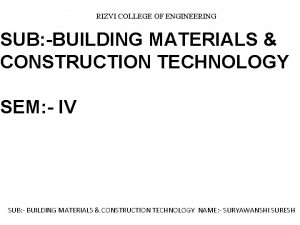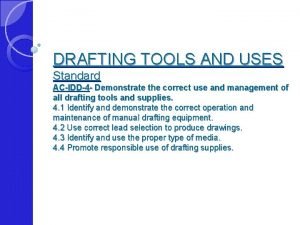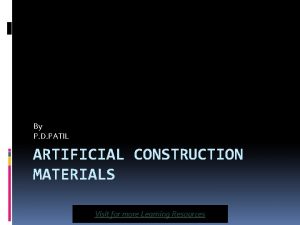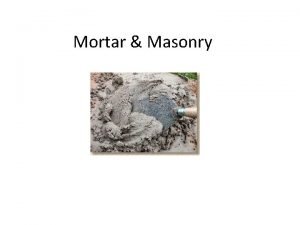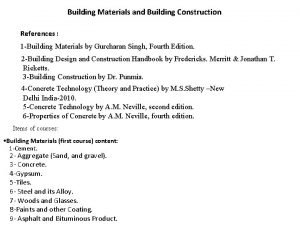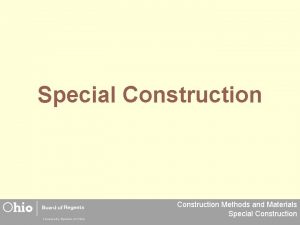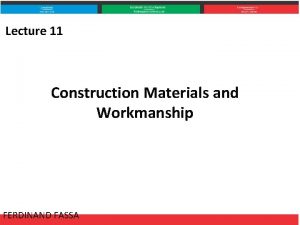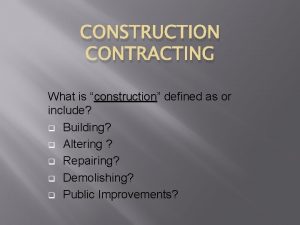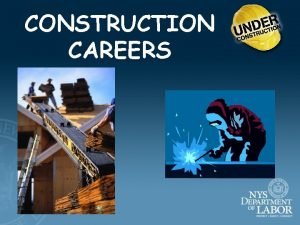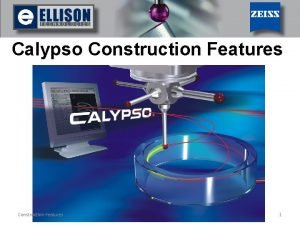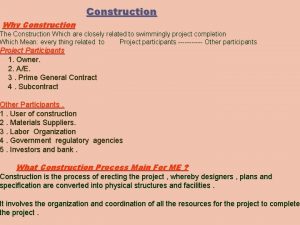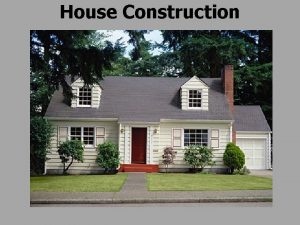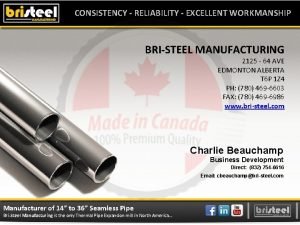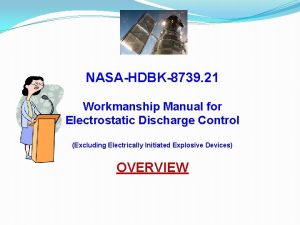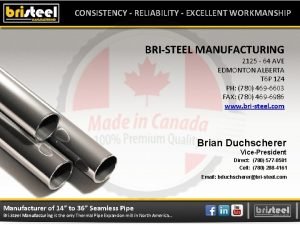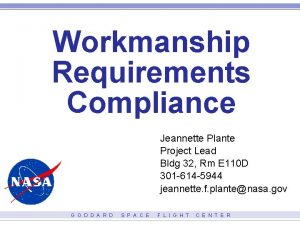Construction Materials and Workmanship All workmanship materials equipment




















- Slides: 20

Construction Materials and Workmanship

• All workmanship, materials, equipment, and articles incorporated into the work are to be of the best available grade in the local trade area • Materials must be free of defects or imperfections • Workmanship is hard to quantify but should be best available.

• Request for substitution of materials – Contractor must give adequate notice of substitution intention – A/E needs time to look at substituted material to see if it is ok – Only allow requests during design phase and construction phase, not during bid phase – RPR must reject any material that isn’t in the specifications or has not been approved by A/E

• Inspection of Materials delivered to site • RPR must inspect all materials before they are used – For some items RPR may do inspection at fabrication plant – precast concrete, steel eams • Precast concrete may sit for months in yard before delivery to site • Not inspecting could hold up job for months

• Rejection of faulty material • RPR must reject faulty materials – Mark materials with an indelible marker and tag them for removal – Want to make sure marks are visible to inspector if used in work and thatthey cannot be rubbed off – All faulty material should be placed in a separate area and removed the same day – Written notice to contractor of rejection

• Equipment – Contractor responsible to have right equipment on site. – RPR can request changes IF it can be established that item can not do job • Tells contractor that equipment is unsatisfactory – RPR can also halt work for safety issues (overloaded crane)

• Quality Assurance – Testing – Installation according to Manufacturer’s instructions – Gillette House used roofing instructions on shingles – Experience Qualification • Prevents “fly by night” firms to get bid • Used for work that requires specialization

• Factory Inspection • Matching Samples on Display during Bidding – Sample shows bidders what is expected – Used for concrete finishes, stone, cabinetry – Samples go with RPR to job site for comparison during inspections

• Proven Successful Use – Contractor must prove that items have been in use in a similar project for a specified time period. • Elevators, pumps, electrical equip – things that need to have a long reliable life – Qualified Products List • Procurement of certain items must be from a list of preapproved items – Possibility of less competition – Need up to date list – Contractor may try to issue a disclaimer for those products

• Certified Lab Reports – Contractor pays for tests and gets a certified report. Report gives method of testing, min level of performance, id of product • • Concrete reinforced steel Steel Fire spread ratings on material Masonry units – Certificate of Compliance or Conformance • Product complies with a specified reference standard • Glass, Paint, Wood

• Ownership of Materials – Contractor owns all materials until final acceptance of the work • Delivery and Storage of materials – Contractor needs to find space – Owner may or may not have space – If contractor rents space RPR must see agreement

• Handling materials – RPR must oversee delivery, storage, and installation of materials – How is material off loaded – How is it stored – How does it get to its final placement

Changes and Extra Work • Change order is a written agreement to modify, add to, or otherwise alter the work from the project in the contract – Alterations must be within scope of contract – Standard practice for owners to make changes in project after contract signed – May have a change order to correct error in the plans

• Changes in the Work • Impact Costs – Indirect costs, increased costs after order signed – Owner should add an addenda to change order saying that price includes all charges for direct and indirect costs arising from the work

• Oral Change orders – Risky – Are legally binding – No written backup to fight claims – Should be followed by a letter which formalizes the change order

• Bilateral Change Orders – Contract addendum – Contractor and owner agree to work • Unilateral Change Order – Intended to expedite issuance of change order to perform emergency or protested work – Must be followed by a written bilateral change order before payment

Basic Principles • 1. No work beyond scope of base contracts – especially on public works • 2. Who is authorized to request and approve change orders • 3. Meet during preconstruction to discuss how to handle change orders • 4. All changes must be authorized in writing before execution of a change

• 5. Scope of change order must be clear – request must be clear enough for contractor to give a good estimate • 6. Contractor’s proposal for change order must be ASAP as should owners approval or rejection • 7. Proposal should be fair to both parties – Contractor should include overhead and profit

• Creates extra work for everybody • Emergency work – RPR can do an Initiator Change Order Request if authorized by owner – Must follow up with a written change order – Protects owner and contractor

 D safety
D safety Jstd001
Jstd001 Nasa workmanship standards
Nasa workmanship standards Bri-steel manufacturing
Bri-steel manufacturing Name 3 points
Name 3 points Construction equipment seats
Construction equipment seats Volvo construction equipment ab
Volvo construction equipment ab Volvo construction equipment ab arvika
Volvo construction equipment ab arvika What is the name of the building
What is the name of the building Used when drawing horizontal lines and support triangles
Used when drawing horizontal lines and support triangles Artificial construction materials
Artificial construction materials What is gauged mortar
What is gauged mortar Construction references
Construction references Special construction examples
Special construction examples Landscape construction materials
Landscape construction materials Natural materials and man made materials
Natural materials and man made materials Material useful or harmful
Material useful or harmful Natural materials and man made materials
Natural materials and man made materials Adopting materials
Adopting materials John donne born
John donne born Direct materials budget with multiple materials
Direct materials budget with multiple materials
